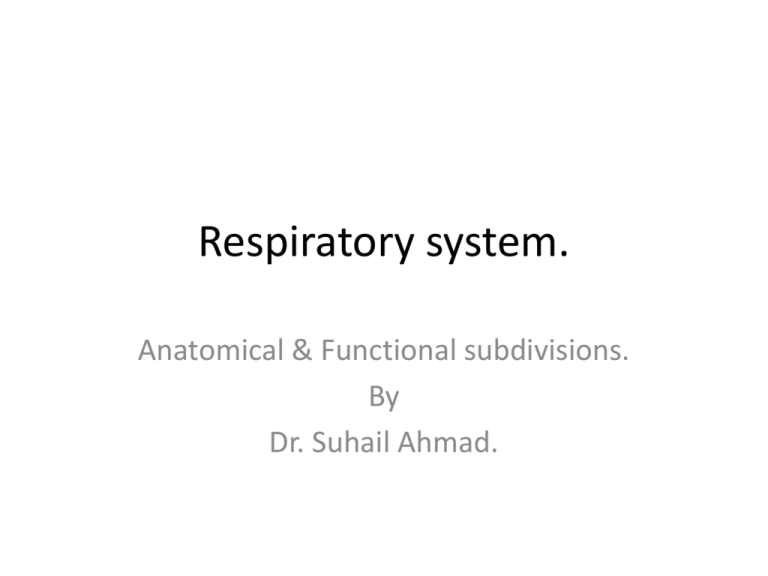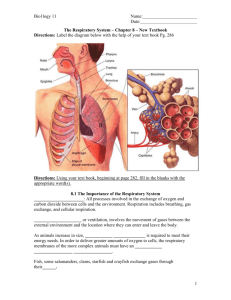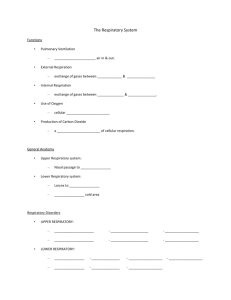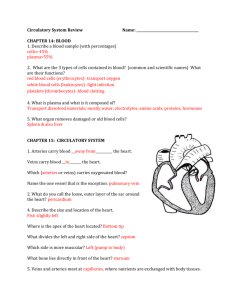Overview Of Respiratory System Anatomy By Dr Sohail Ahmed 02
advertisement

Respiratory system. Anatomical & Functional subdivisions. By Dr. Suhail Ahmad. The Respiratory System Organization and Functions of the Respiratory System Structural classifications: – upper respiratory tract – lower respiratory tract. Upper Respiratory Tract • Composed of – the nose – the nasal cavity – the paranasal sinuses – the pharynx (throat) – and associated structures. • All part of the conducting portion of the respiratory system. Lower Respiratory Tract • Conducting portion – Larynx – Trachea – Bronchi – bronchioles and their associated structures • Respiratory portion of the respiratory system – respiratory bronchioles – alveolar ducts – alveoli Organization of the Respiratory System • Functional classifications: –Conducting portion: transports air. • Nose • nasal cavity • Pharynx • Larynx • Trachea • progressively smaller airways, from the primary bronchi to the bronchioles Organization of the Respiratory System • Functional classifications: continued – Conducting portion: transports air. – Respiratory portion: carries out gas exchange. • respiratory bronchioles • alveolar ducts • air sacs called alveoli • Upper respiratory tract is all conducting • Lower respiratory tract has both conducting and respiratory portions The Respiratory Organs Conducting zone – Respiratory passages that carry air to the site of gas exchange – Filters, humidifies and warms air Respiratory zone – Site of gas exchange – Composed of • Respiratory bronchioles • Alveolar ducts • Alveolar sacs Conducting zone labeled Respiratory System Functions • Breathing (pulmonary ventilation): – consists of two cyclic phases: • inhalation, also called inspiration • exhalation, also called expiration – Inhalation draws gases into the lungs. – Exhalation forces gases out of the lungs. • Gas exchange: O2 and CO2 – External respiration • External environment and blood – Internal respiration • Blood and cells Respiratory System Functions • Gas conditioning: – Warmed – Humidified – Cleaned of particulates • Sound production: – Movement of air over true vocal cords – Also involves nose, paranasal sinuses, teeth, lips and tongue • Olfaction: – Olfactory epithelium over superior nasal conchae • Defense: – Course hairs, mucus, lymphoid tissue Nose • • • • Provides airway Moistens and warms air Filters air Resonating chamber for speech • Olfactory receptors External nose Skeletal framework Bones that contribute to the skeletal framework of the nasal cavities include: • The unpaired – Ethmoid – Sphenoid, – Frontal bone – Vomer • The paired – Nasal – Maxillary – Palatine – Lacrimal Bones – Inferior Conchae Regions • Each nasal cavity consists of three general regions. • The nasal vestibule is a small dilated space just internal to the naris that is lined by skin and contains hair follicles; • The respiratory region is the largest part of the nasal cavity, has a rich neurovascular supply, and is lined by respiratory epithelium composed mainly of ciliated and mucous cells; • The olfactory region is small, is at the apex of each nasal cavity, is lined by olfactory epithelium, and contains the olfactory receptors Lateral wall • The lateral wall is characterized by three curved shelves of bone (conchae) – which are one above the other and – project medially and inferiorly across the nasal cavity. • The medial, anterior and posterior margins of the conchae are free. The conchae divide each nasal cavity into four air channels: • an inferior nasal meatus between the inferior concha and the nasal floor; • a middle nasal meatus between the inferior and middle concha; • a superior nasal meatus between the middle and superior concha; and • a spheno-ethmoidal recess between the superior concha and the nasal roof. • These conchae increase the surface area of the lateral wall. • The openings of the paranasal sinuses are on the lateral wall and roof of the nasal cavities. • The lateral wall also contains the opening of the nasolacrimal duct, which drains tears from the eye into the nasal cavity. Medial wall • The medial wall of each nasal cavity is the mucosa-covered surface of the thin nasal septum • Oriented vertically in the median sagittal plane • Separates the right and left nasal cavities from each other. Medial wall • The nasal septum consists of: – the septal nasal cartilage anteriorly – posteriorly, mainly the vomer and the perpendicular plate of the ethmoid bone Nasal septum(medial wall). Blood supply The nasal cavities have a rich vascular supply for altering the humidity and temperature of respired air. • vessels that originate from branches of the external carotid artery include: – – – – sphenopalatine greater palatine superior labial lateral nasal arteries • vessels that originate from branches of the internal carotid artery are: – anterior ethmoidal – posterior ethmoidal Blood supply Innervation • Innervation of the nasal cavities is by three cranial nerves. olfaction is carried by the olfactory nerve [I]; • General sensation is carried by the trigeminal nerve [V], the anterior region by the ophthalmic nerve [V1], and the posterior region by the maxillary nerve [V2]; • All glands are innervated by parasympathetic fibers in the facial nerve [VII] (greater petrosal nerve), which joins branches of the maxillary nerve [V2] in the pterygopalatine ganglion. Innervation Lymphatic drainage. Paranasal Sinuses • Paranasal sinuses: – In four skull bones – paired air spaces – decrease skull bone weight • Named for the bones in which they are housed. – – – – frontal ethmoidal sphenoidal maxillary • Communicate with the nasal cavity by ducts. • Covered with the same pseudostratified ciliated columnar epithelium as the nasal cavity. Paranasal Sinuses Paranasal sinuses – Can get infected: sinusitis Paranasal Sinuses PHARYNX • The pharynx is a musculo-fascial tube behind the nasal and oral cavities. • Funnel-shaped – slightly wider superiorly and narrower inferiorly. • Its anterior wall is largely deficient and through this defect it communicates with the: – Nasal cavities – Oral cavity – Larynx • The pharyngeal cavity is a common pathway for air and 'food'. PHARYNX • The pharynx is attached above to the base of the skull. • It is continuous below with esophagus in the neck. PHARYNX • Based on the anterior relationships the pharynx is subdivided into three regions: – nasopharynx – oropharynx – laryngopharynx • The posterior apertures (choanae) of the nasal cavities open into the nasopharynx; • The posterior opening of the oral cavity (oropharyngeal isthmus) opens into the oropharynx; • The superior aperture of the larynx (laryngeal inlet) opens into the laryngopharynx. Pharynx • Walls: – lined by a mucosa – contain skeletal muscles primarily used for swallowing. • Flexible lateral walls – distensible – to force swallowed food into the esophagus. Larynx • Short, somewhat cylindrical airway • Location: – bounded posteriorly by the laryngopharynx, – inferiorly by the trachea. • Prevents swallowed materials from entering the lower respiratory tract. • Conducts air into the lower respiratory tract. • Produces sounds. Larynx • Nine pieces of cartilage – three individual pieces • Thyroid cartilage • Cricoid cartilage • Epiglottis – three cartilage pairs • Arytenoids: on cricoid • Corniculates: attach to arytenoids • Cuniforms:in aryepiglottic fold Nine pieces of cartilage – held in place by ligaments and muscles. • Intrinsic muscles: regulate tension on true vocal cords • Extrinsic muscles: stabilize the larynx • Framework of the larynx – 9 cartilages connected by membranes and ligaments – Thyroid cartilage with laryngeal prominence (Adam’s apple) anteriorly – Cricoid cartilage inferior to thyroid cartilage: the only complete ring of cartilage: signet shaped and wide posteriorly – Behind thyroid cartilage and above cricoid: 3 pairs of small cartilages 1. Arytenoid: anchor the vocal cords 2. Corniculate 3. Cuneiform – 9th cartilage: epiglottis Trachea • A flexible, slightly rigid tubular organ – often referred to as the “windpipe.” • Extends through the mediastinum – immediately anterior to the esophagus – inferior to the larynx – superior to the primary bronchi of the lungs. Trachea • Anterior and lateral walls of the trachea are supported by 15 to 20 C-shaped tracheal cartilages. – cartilage rings reinforce and provide some rigidity to the tracheal wall to ensure that the trachea remains open (patent) at all times – cartilage rings are connected by elastic sheets called anular ligaments Trachea • At the level of the sternal angle(T-4), the trachea bifurcates into two smaller tubes, called the right and left primary bronchi. • Each primary bronchus projects laterally toward each lung. • The most inferior tracheal cartilage separates the primary bronchi at their origin and forms an internal ridge called the carina. • Ridge on internal aspect of last tracheal cartilage • Point where trachea branches (when alive and standing is at T7) • Mucosa highly sensitive to irritants: cough reflex Carina* * 53 Bronchial Tree • A highly branched system – air-conducting passages – originate from the left and right primary bronchi. • Progressively branch into narrower tubes as they diverge throughout the lungs before terminating in terminal bronchioles. • Primary bronchi –Incomplete rings of hyaline cartilage ensure that they remain open. –Right primary bronchus • shorter, wider, and more vertically oriented than the left primary bronchus. –Foreign particles are more likely to lodge in the right primary bronchus. Bronchial Tree • Primary bronchi – enter the hilum of each lung • Secondary bronchi (or lobar bronchi) – Branch of primary bronchus – left lung: • two lobes • two secondary bronchi – right lung • three lobes • three secondary bronchi. • Tertiary bronchi (or segmental bronchi) – Branch of secondary bronchi – left lung is supplied by 8 to 10 tertiary bronchi. – right lung is supplied by 10 tertiary bronchi – supply a part of the lung called a bronchopulmonary segment. Respiratory Bronchioles, Alveolar Ducts, and Alveoli • Contain small saccular outpocketings called alveoli. • An alveolus is about 0.25 to 0.5 millimeter in diameter. • Its thin wall is specialized to promote diffusion of gases between the alveolus and the blood in the pulmonary capillaries. • The spongy nature of the lung is due to the packing of millions of alveoli together. Respiratory Bronchioles, Alveolar Ducts, and Alveoli • Gas exchange can take place in the respiratory bronchioles and alveolar ducts as well as in the lungs, which contain approximately 300– 400 million alveoli. Pleura and Pleural Cavities • The outer surface of each lung is tightly covered by the visceral pleura • Internal thoracic walls, the lateral surfaces of the mediastinum, and the superior surface of the diaphragm are lined by the parietal pleura. • The parietal and visceral pleural layers are continuous at the hilum of each lung. Pleura and Pleural Cavities • The potential space between these serous membrane layers is a pleural cavity. • The pleural membranes produce a thin, serous fluid that circulates in the pleural cavity and acts as a lubricant, ensuring minimal friction during breathing. 67 CXR (chest x-ray) 68 Chest x rays Normal female Lateral (male) Pneumothorax • There are many diseases of the respiratory system, including asthma, cystic fibrosis, COPD (chronic obstructive pulmonary disease – with chronic bronchitis and/or emphysema) and epiglottitis example: normal emphysema you might want to think twice about smoking…. 72








